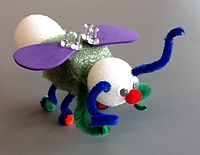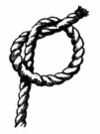IGEM Outreach:Activities
DNA Necklaces
- Cornell iGEM 2011
- Adapted from protocol developed by the Cornell Institute of Biology Teachers
- Suitable for: all ages
 Figure 1.1: DNA necklace: 1.5mL culture tube filled with wheat germ DNA on a string of yarn
Figure 1.1: DNA necklace: 1.5mL culture tube filled with wheat germ DNA on a string of yarn
Introduction
A major topic in modern biology research is DNA. The Human Genome Project, DNA fingerprinting, evolution studies, genetic diseases and tests, and bio-production are just a few applications that society has heard of for DNA. All of these techniques require a technician to remove DNA from a cell. (Remember, eukaryotes require an extra step—removing DNA from the nucleus.) In this activity, you will be the lab technician removing the DNA! Each step in the isolation process exists because of the characteristics of DNA.
Materials per person
- Fresh raw wheat germ
- Meat tenderizer
- Hot water (shower temp)
- Wooden skewer
- Wash bottle filled with detergent (can be shared in a group)
- Propylene tube (10mL suggested)
- One 1.5mL microcentrifuge tube
- Ice-cold 100% ethanol (leave on ice until needed)
- Small cup or beaker
- One string of yarn
Procedure
- Mix 50mL hot water and 1.5 g wheat germ in a small cup or beaker.
- Stir with wooden skewer.
- Add 2 squirts of detergent. (Detergent dissolves the lipid cell membranes.)
- Add 1.5g of meat tenderizer. (The tenderizer contains papain enzyme, which breaks down protein. This removes the histone proteins from DNA.)
- Stir for 2 minutes.
- Let the mixture sit for 2 minutes.
- Pour the liquid part of the solution into a 10mL polypropylene tube—leave most of the wheat germ in the cup. (The DNA should be in the solution.) Fill the tube halfway.
- Pour ice-cold ethanol SLOWLY down the inside edge of the tube you filled in step 7. Fill the tube almost to the top. (The ethanol helps the DNA come out of solution.)
 Figure 1.2: DNA precipitating from wheat germ in 10mL propylene tube
Figure 1.2: DNA precipitating from wheat germ in 10mL propylene tube
- DNA strands will begin to precipitate and form! Yes, they look like snot. Twist the DNA onto the wooden skewer. (This is called spooling the DNA.) DO NOT STIR OR SHAKE!
- Place the DNA in the 1.5mL microcentrifuge tube. Place a few drops of remaining liquid into the tube along with the DNA.
- String the yarn where the cap of the 1.5mL tube connects to its body and seal the cap on the tube.
- Enjoy your DNA necklace!
Experience
- Transfer pipette in step #7 = good alternative to pouring. Cornell iGEM 2011
- Step #11: consider hot-gluing the tube closed if you're helping young children. (The'll want to pop the cap off.) Cornell iGEM 2011
Build-A-Bug
- Cornell iGEM 2011
- Adapted from lesson plan developed by Ernie Richmann (Hobart Middle School in Painesville, OH) and the Cornell Institute of Biology Teachers
- Suitable for: all ages
Introduction
Students build a model insect based upon the genetic information provided to them. Gene forms (alleles) contributed by each parent are determined by tossing a coin with one side representing the dominant form and the other side representing the recessive form. Students note the geneotype and phenotype of each trait and then build the insect using inexpensive, readily available materials.
Learning Objectives
- Organisms inherit genetic information in a variety of ways that result in continuity of structure and function between parents and offspring.
- Hereditary information is carried in genes, which are composed of DNA.
- Each gene carries one unit of information.
- In sexual reproduction, typically half of the genes come from each parent. Sexually produced offspring are not identical to their parents.
- Genetic traits are passed on from generation to generation.
- Some genes are dominant, and others are recessive.
- Central dogma ⇒ DNA to mRNA to protein
- There are two parts to this activity—one to do during an outreach presentation, and another variation for children to take home with them.
I) Activity during presentation: genotype specifies phenotype
- Objective: build an insect from arts and crafts materials
Materials
- Two two-sided coins (each coin represents one parent)
- Assorted craft materials for insect head, antennae, eyes, legs, wings, stingers, pincers, and proboscis—materials found in crafts stores. For example:

Figure 2.1: Completed Build-A-Bug and its buggy body parts, from L to R: body segments (styrofoam and googly eyes), pointy wings and curvy wings (foam sheets), legs (pipe cleaners and pom pom balls), spiral antennae and straight antennae (pipe cleaners), and spiral pincers and bent pincers (bumpy pipe cleaners cut in segments)
- Birth certificates for insects
Procedure
- Note: Each insect parent is heterozygous for all traits. Genes exhibit complete dominance; heterozygote's phenotype = dominant homozygote's phenotype.
- Designate which side of the coin (heads or tails) = dominant gene and determine which phenotype = dominant. Tell this information to the students.
- For each trait—big/ small eyes, curvy/ pointed wings, stingers vs. pincers, etc—each student flips a coin twice. Each coin flip = allele given by one parent.
- Students then determine and write down the genotype (ex: Ee for eyes) of each trait on their insect's birth certificate.
- Students then discern the phenotypes from the geneotypes and construct their insect using the provided arts and crafts materials.
Experience, Part (I)
II) Post-presentation take-home activity: adding bug proteins to DNA necklace
 Figure 2.2: DNA necklace with beaded Build-A-Bug "proteins"
Figure 2.2: DNA necklace with beaded Build-A-Bug "proteins"
- Objective: Make beaded "proteins" that determine the Build-A-Bug body part phenotypes and attach them to a DNA necklace. The DNA necklace will therefore represent the "central dogma" of biological information flow.
Materials (for each student), all contained in a large sealable bag
- Colored cord cut in 6-inch pieces
- 20 different kinds of beads—at least 5 of each kind, all contained in small plastic bags. List what color/ size/ type of bead goes with __ amino acid
- Instruction sheet of body part phenotypes and the DNA sequences that code for them. Each "protein" should be composed of 3 to 5 amino acids.
- Worksheet for students to write down DNA, mRNA, and amino acid sequences associated with each body part (will be posted soon)
- Codon table
Procedure
A) Obtain amino acid sequences of proteins that determine phenotype
- Use provided information sheet to look up the DNA sequence for each of the bug body part phenotypes.
- Copy down DNA letters on worksheet.
- Transcribe DNA to mRNA by writing down the complimentary base pairs to the DNA sequences and replacing thymine, T, with uracil, U. (Worksheet will have spaces in between every 3 mRNA letters to form codons.)
- Look up amino acids to go w/ each codon (3-letter mRNA group) in codon tables provided on the worksheet.
- Write down amino acid sequences on worksheets and place beads on flat surface
B) Make the proteins and attach them to the DNA necklace. For each protein:
- Fold a piece of cord around the necklace strand such that the cord piece is divided in half. Keep the cord ends parallel and use them to tie a (double-stringed) overhand knot such that the cord is secured to the necklace but can still slide up and down the necklace strand.
- String both ends of the cord through the amino acid beads.
- Tie (single-string) overhand knots on the end to keep the beads from falling off.
⇒ Repeat all of the steps above to make a protein corresponding to each body part phenotype.
The end product will be a necklace containing a vial of wheat germ DNA and "proteins" corresponding to Build-A-Bug phenotypes on each side of the vial.









